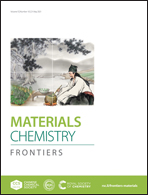Rubbing-assisted approach for highly-oriented collagen fibril arrays involving calcium phosphate precipitation†
Abstract
Highly-oriented homogeneous collagen (Col) fibril arrays were successfully fabricated on a rubbed polyimide (PI) film for precipitating calcium phosphate (CP). The surface functional groups of PI were aligned using the rubbing treatment, where the C![[double bond, length as m-dash]](https://www.rsc.org/images/entities/char_e001.gif) O bonds in imide groups had transition moments perpendicular to the rubbing direction and the C
O bonds in imide groups had transition moments perpendicular to the rubbing direction and the C![[double bond, length as m-dash]](https://www.rsc.org/images/entities/char_e001.gif) C (benzene rings), C–N and C–O–C bonds had transition moments parallel to the rubbing direction. After the Col molecular solution was spin-coated and self-assembled on the rubbed PI film, the Col fibrils parallel to the rubbing direction with an orientation ratio of 68 to 91% and a density of 121 ± 7 to 225 ± 22 number per mm were successfully formed on the rubbed PI film, indicating the occurrence of the interfacial interactions between the PI and Col molecules. Moreover, the carboxyl groups (–COOH) on the Col fibrils were used as the CP nucleation sites for Ca2+ ion adsorption, and subsequently the nucleation of CP was promoted by immersing the Col fibrils into a simulated body fluid. Specifically, the CP crystals were effectively precipitated on the Col fibrils and plate-like CP crystals were formed along the direction of Col fibril arrays. Therefore, this provides an effective method for the fabrication of one-directional Col fibril arrays as well as CP/Col fibrous nanostructures using a biomimetic process.
C (benzene rings), C–N and C–O–C bonds had transition moments parallel to the rubbing direction. After the Col molecular solution was spin-coated and self-assembled on the rubbed PI film, the Col fibrils parallel to the rubbing direction with an orientation ratio of 68 to 91% and a density of 121 ± 7 to 225 ± 22 number per mm were successfully formed on the rubbed PI film, indicating the occurrence of the interfacial interactions between the PI and Col molecules. Moreover, the carboxyl groups (–COOH) on the Col fibrils were used as the CP nucleation sites for Ca2+ ion adsorption, and subsequently the nucleation of CP was promoted by immersing the Col fibrils into a simulated body fluid. Specifically, the CP crystals were effectively precipitated on the Col fibrils and plate-like CP crystals were formed along the direction of Col fibril arrays. Therefore, this provides an effective method for the fabrication of one-directional Col fibril arrays as well as CP/Col fibrous nanostructures using a biomimetic process.



 Please wait while we load your content...
Please wait while we load your content...